In an era where digital interactions shape consumer-brand connections, marketing, and technology integration is known as MarTech. Once a specialized area, marketing technology has quickly become a core element of contemporary business strategies, revolutionizing how companies connect with customers, analyze data, and drive their marketing and sales efforts. The rise of marketing and technology has been driven by cutting-edge advancements such as AI, ML, big data, and personalized customer experiences, transforming sales and marketing strategies. This blog will delve into B2B tech marketing, exploring key trends, components, benefits, and challenges, including optimizing your martech stack for effective lead generation and efficient marketing operations.
What is Martech?
Martech, short for marketing technology, encompasses a broad range of tools and software within the marketing industry designed to streamline and enhance marketing activities. It includes various platforms and applications that help businesses automate processes, analyze intent data, and improve customer experiences. At its core, it aims to optimize marketing strategies by leveraging advanced digital marketing technology such as AI. Martech companies provide these tools, enabling businesses to gain deep insights into customer behavior, tailor sales and marketing efforts with greater precision, and deliver personalized messages that resonate with target audiences, ultimately driving demand generation and customer engagement.

A well-integrated B2B martech stack improves operational efficiency by automating routine tasks, minimizing errors, and ensuring a seamless flow of information across marketing platforms. This integrated marketing leads to a more coherent and personalized customer experience, enhancing engagement, boosting conversion rates, and ultimately driving revenue growth. Martech companies help businesses enhance their marketing effectiveness and gain a competitive edge. By adopting these technologies, businesses can navigate digital disruptions more effectively, capitalize on new channels, and retain a larger, more engaged user base. Advanced analytics tools within marketing tech also provide real-time performance tracking, a key part of current marketing trends, allowing for continuous optimization of marketing campaigns for better results.
For a detailed exploration of martech and intent data, tune into our podcast with marketing legend David Raab. Renowned for his work in Customer Data Platforms and the MarTech space, he offers valuable insights into today’s AI-driven landscape.
Benefits of Martech Adoption in B2B
Elevated customer experience: In B2B technology marketing, martech solutions provide businesses with valuable insights into customer behavior, preferences, and challenges, enabling them to create highly personalized and engaging experiences. By tailoring interactions to individual needs, companies can foster stronger brand loyalty, align with their go-to-market strategy, and drive higher conversion rates. For example, personalized email campaigns can significantly enhance customer engagement and GTM strategy.
Increased efficiency and productivity: Martech solutions automate and streamline various marketing tasks and marketing operations by reducing manual work and eliminating redundancies. This automation allows sales and marketing teams to focus on strategic planning, creative projects, and high-impact activities like demand generation, ultimately improving productivity and return on investment (ROI). Email automation and social media scheduling exemplify how digital marketing technology boosts operational efficiency.
Data-driven decision making: Martech platforms offer a wealth of data and analytics, empowering marketers to make informed decisions based on real-time insights. By analyzing customer behavior, campaign performance, and market trends, businesses can optimize their strategies, allocate resources more effectively, and maximize their marketing impact. Platforms like Google Analytics and Adobe Analytics provide critical insights that inform strategic planning.
Scalability and agility: As businesses grow and expand into new markets, martech solutions provide the scalability and flexibility needed to adapt to changing customer needs and market dynamics. These tools enable rapid deployment and optimization of campaigns across multiple channels, helping businesses stay ahead of the competition and seize emerging opportunities. One martech example, Bravo, allows companies to effeciently scale their email marketing and automation operations.
Enhanced collaboration and integration: Martech platforms often integrate seamlessly with other business systems and tools, facilitating better collaboration and data sharing across departments. This integration leads to a more cohesive and aligned approach to marketing, sales, and customer service, ultimately improving the overall customer experience. For example, Slack can integrate with CRM and project management solutions, fostering unified efforts across teams.
Smarter content creation: Martech enables businesses to use intent data and insights to understand what content resonates best with their audience, leading to more effective and targeted content creation. By leveraging this data, companies can produce content that is more likely to engage their target audience. As a martech example, Demandbase leverages intent data to track browsing patterns and keywords, pinpointing key decision-makers and their interests for more effective content and engagement.
Key Elements of the B2B Marketing Tech Stack
Customer Relationship Management (CRM) Systems
CRM systems are foundational in any B2B marketing tech stack, serving as the central hub for managing customer and prospect data, which is a crucial component of marketing technology services. They track interactions, automate various aspects of the customer journey, and help maintain comprehensive customer profiles. This centralization of information allows marketers to deliver personalized experiences, streamline communication, and optimize customer relationship management, ultimately enhancing customer retention and satisfaction.
Marketing Automation Platforms
These platforms are essential for executing and managing marketing campaigns across multiple channels. They enable marketers to automate repetitive tasks, such as email marketing and social media postings, while also offering advanced segmentation and targeting capabilities. By automating these processes, martech industry tools empower marketing teams to enhance both strategy and creativity.
Content Management Systems (CMS)
In B2B technology marketing, a CMS is crucial for managing digital content, including blogs, white papers, and case studies. It allows marketers to create, edit, and publish content without needing technical expertise, making maintaining a dynamic and relevant online presence easier. By simplifying content management, a CMS enables more consistent and timely updates, which are key to engaging customers and improving SEO rankings.
Social Media Management Tools
Managing social media across various platforms is streamlined with tools that schedule posts, engage with followers, and analyze performance. These tools are vital for maintaining a strong social media presence, which is increasingly important in B2B tech marketing. They help ensure consistent communication and allow for real-time engagement with customers, while also providing valuable metrics to gauge the impact of social media efforts. By effectively leveraging these tools, you can also get leads for your business and drive meaningful interactions that contribute to your overall marketing goals.
SEO and Search Marketing Tools

SEO tools are indispensable for capturing organic traffic and optimizing paid search campaigns. They assist in keyword research, competitor analysis, and tracking page rankings, all of which are crucial for improving a website’s visibility in search engine results. Effective use of SEO tools like SEMrush, Ahrefs, Ubersuggest and more, It can significantly boost a company’s online presence, driving more targeted traffic and increasing lead and demand generation.
How Does the Martech Ecosystem Simplify Daily Operations?
The marketing technology ecosystem is a dynamic network of tools and platforms designed to optimize every phase of the marketing funnel, making daily operations more efficient, effective, and data-driven. Let’s explore how different components of this ecosystem streamline marketing activities, helping businesses achieve better results.
Content Management Systems (CMS)
Content is at the heart of every marketing strategy, and CMS platforms like WordPress, Adobe Experience Manager, and Sitecore play a pivotal role in managing it. These systems empower marketers to effortlessly create, manage, and publish content across multiple digital channels. By providing a consistent and cohesive brand experience, CMS platforms ensure that your messaging remains unified, whether it’s on a website, blog, or social media.
Customer Relationship Management (CRM)
Understanding and nurturing customer relationships is crucial for any marketing effort. CRM platforms such as Salesforce and HubSpot are indispensable in this regard. What role can a CRM play in an effective martech stack? CRMs allow marketers to track customer interactions, manage lead generation, and gain deep insights into customer behavior. This information is invaluable for crafting targeted marketing campaigns that resonate with specific audience segments, ultimately driving higher engagement and conversions.
Marketing Automation
Marketing automation platforms, such as Marketo and Pardot, are examples of marketing technology essential for executing and managing campaigns. These tools automate a wide range of marketing activities, from email campaigns and lead generation and social media management and campaign execution. By automating these tasks, marketers can focus on strategic initiatives, improving overall efficiency and scalability.
Analytics and Reporting
In today’s data-driven world, making informed decisions is essential. Tools like Google Analytics, Adobe Analytics, and Mixpanel provide in-depth insights into customer behavior, campaign performance, and website metrics. These analytics platforms allow marketers to track what’s working and what’s not, enabling data-driven decisions that optimize marketing strategies for better outcomes.
Artificial Intelligence (AI) and Machine Learning (ML)
AI and ML are revolutionizing marketing by bringing predictive analytics, personalized recommendations, and intelligent automation to the forefront. These technologies enhance the precision of marketing campaigns by predicting customer behavior, tailoring content to individual preferences, and automating complex processes, thereby driving better engagement and ROI.

Omnichannel Marketing
Consistency across channels is key to a successful marketing strategy. Platforms like Adobe Experience Cloud and Salesforce Marketing Cloud facilitate omnichannel marketing, allowing businesses to deliver personalized and cohesive experiences across websites, mobile apps, social media, and more. By integrating these channels, businesses can ensure that their message reaches customers at the right time and place, creating a seamless and engaging customer journey.
Building a Winning B2B MarTech Stack
Building winning tech marketing technology is a strategic process that requires careful planning, research, and collaboration. Whether you’re starting from scratch as a new company or working to integrate and streamline existing tools, here’s a step-by-step guide to help you build an effective technology stack.
Define your B2B marketing strategies and goals: Start by clarifying what you want to achieve with your B2B technology marketing tools. Are you aiming to increase conversions, generate more marketing lead generation, enhance brand awareness, or achieve something else? Understanding your goals and how they align with your go-to-market strategy will help you select tools that best meet your needs and provide the most value to your marketing efforts.
Assess existing tools: Most businesses already use some form of marketing technology. Take inventory of your current tools and evaluate what’s working well and what’s not. Identify any gaps or issues with your existing technology. This assessment will help you understand what additional tools might be needed and how well new solutions can integrate with your current setup.
Consult with your team: Involve your team in the decision-making process. Gather input on their experiences, challenges, and needs. Ask them what tools or features could make their jobs easier and which current tools are falling short. Even if they can’t name specific solutions, their feedback will give you valuable insights into improving your marketing workflows.
Set a budget: Determine how much you can afford to spend on new martech solutions. Consider not only the purchase costs but also factors like implementation, maintenance, and training. Establishing a clear budget will help you narrow down your options and present a more convincing case to decision-makers.
Shortlist tools: Based on your research, create a shortlist of tools that align with your goals and budget. Look for tools that integrate well with your existing systems, align with emerging marketing trends, and offer features that address your specific needs. Rank each option by how much it could benefit your marketing efforts and evaluate the total cost, including any necessary training.
Implement tools: Once you’ve selected the best tools, start implementing them. Connect the tools to create a unified system that provides a comprehensive view of your marketing strategy and customer interactions. Ensure your team receives proper training and resources to use the new tools effectively. Encourage them to provide feedback on how the tools impact their work.
Adjust based on performance: Regularly review the performance of your tech stack to ensure it’s meeting your objectives. Assess whether each tool is enhancing productivity, ROI, and lead generation. Be prepared to make adjustments if certain tools aren’t performing as expected. In some cases, this might mean tweaking how you use a tool, while in others, it might involve replacing it with a better solution.
Best Practices for Martech Implementation
Adding tools to your marketing toolbox doesn’t automatically lead to improved productivity or better campaign performance. To ensure the successful adoption of a platform, here are some essential tips:
Prioritize easy integrations: One of the most crucial aspects of adopting platforms is ensuring they integrate seamlessly with your existing systems. Start by evaluating your marketing strategy and how your chosen tools will fit into it. Early planning and careful selection of platforms that work well together can save time and reduce complications down the road.
Limit your stack: While it might be tempting to accumulate as much technology as possible, too many platforms can overwhelm your team and drain resources. Focus on tools that offer the most relevant features and easiest integrations. Before adding a new platform, consider how it aligns with marketing trends and your business goals to avoid unnecessary complexity.
Communicate with your team: Effective communication with your team is vital when adopting new martech. Gather input from team members to understand their needs and preferences. Once a platform is in place, establish communication channels to gather feedback, quickly address any issues, and ensure everyone is on the same page.
Promote ongoing training: Training is key to getting the most out of your tech investment. While some team members may use the software more than others, providing training for everyone ensures that the entire team understands the platform’s capabilities and can use it effectively.
Manage expectations: It’s important to manage expectations when adopting new technology. Marketing technology platforms may take time—months or even years—to show significant results. Setting realistic expectations help avoid premature decisions to abandon useful tools before they have a chance to prove their value.

Practical Tips to Prevent Martech Pitfalls
A well-planned martech strategy can boost marketing efforts and help businesses achieve their strategic goals. However, to avoid common pitfalls, it’s crucial to follow these practical tips:
Prioritize growth over cost-cutting: While it might be tempting to cut costs, especially in the early stages of a startup, reducing marketing expenses can hinder growth. Effective marketing requires time and consistent effort. to yield results. Even if implementing marketing technology initially increases costs, it’s an investment that can lead to long-term profitability. Focus on growth and be prepared for the upfront expenses to pay off over time.
Set realistic targets: Unrealistic expectations from technology reforms can do more harm than good. It’s essential to align business goals with martech strategy. Setting achievable targets prevents missed deadlines, poor-quality work, and increased costs. It also maintains team morale and ensures that your martech strategy supports, rather than hinders, business success.
Avoid overloading with tools: With so many martech tools available, it’s easy to fall into the trap of buying more than necessary. Before investing in new tools, evaluate B2B martech stack examples to ensure they meet your needs and integrate well with your existing systems. Research the tools thoroughly, considering their integration capabilities, user feedback, and relevance to your specific business goals.
Adapt to customer behavior changes: Customer behavior is constantly evolving, and marketing strategies must adapt accordingly. Failing to align marketing efforts with these changes can lead to wasted time and resources. An agile approach to customer experience, capable of handling both behavioral and technological shifts, is essential for staying competitive in a rapidly changing market.
The Future of MarTech in B2B: What to Expect in 2025
In 2025, the future of martech strategy will be largely shaped by advancements in artificial intelligence (AI). With AI-driven martech tools, businesses will be able to predict customer behaviors and tailor personalized experiences. These technologies will dramatically alter how marketers interact with customers and refine their campaigns. AI and machine learning (ML) will enhance predictive analytics, allowing marketers to anticipate customer behaviors and trends with exceptional precision. As AI continues to evolve, personalization and marketing trends will also see remarkable improvements. By analyzing large data sets in real time, AI will enable marketers to craft highly personalized experiences for millions of customers simultaneously. Salesforce’s Einstein AI is already setting the stage with its ability to tailor interactions, boosting engagement and conversion rates using martech tools.
The rise of AI will also impact human labor in marketing and technology. Routine tasks will become automated, freeing up marketers to focus on more strategic and creative roles. This shift will necessitate new skills in data analysis and AI management. Similarly, enhanced Customer Data Platforms (CDPs) will evolve to create unified customer profiles, integrating data from various sources for a comprehensive view of customer interactions. This will improve segmentation and targeting.
As marketing technology evolves, privacy will become increasingly important. CDPs will need to prioritize security and comply with global data protection regulations to maintain customer trust. Voice and visual search will also gain prominence, with voice searches expected to constitute 50% of all searches by 2025. Brands like Pinterest are already leveraging visual search to enhance the user experience. Omnichannel marketing will advance, ensuring consistent and seamless customer interactions across all touchpoints. Real-time engagement and advanced marketing automation, including AI-powered chatbots, will further reshape the marketing landscape, making it essential for marketers to adapt to these new tools and technologies.
Conclusion
In conclusion, setting up a successful martech stack requires a strategic approach, balancing technology with business objectives. By carefully selecting and integrating tools that align with your marketing goals and GTM strategy, you can enhance efficiency, optimize lead generation, enhance demand generation, drive personalized customer experiences, and make data-driven decisions. Embracing emerging trends such as AI and machine learning will future-proof your stack, enabling you to stay ahead in the dynamic B2B sales and marketing landscape. With the right marketing technology, you’ll be well-equipped to optimize your marketing efforts, foster growth, and achieve long-term success.




